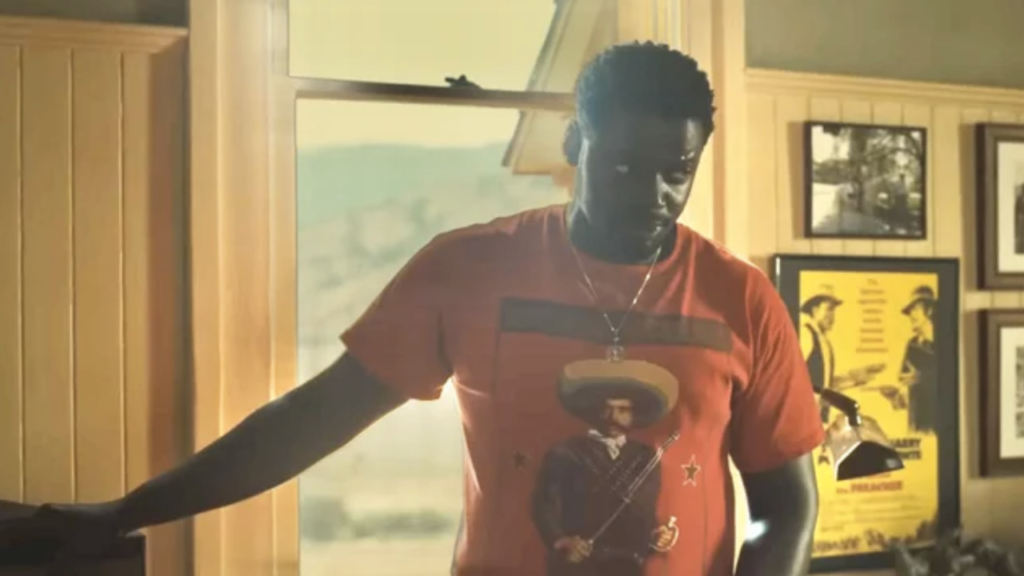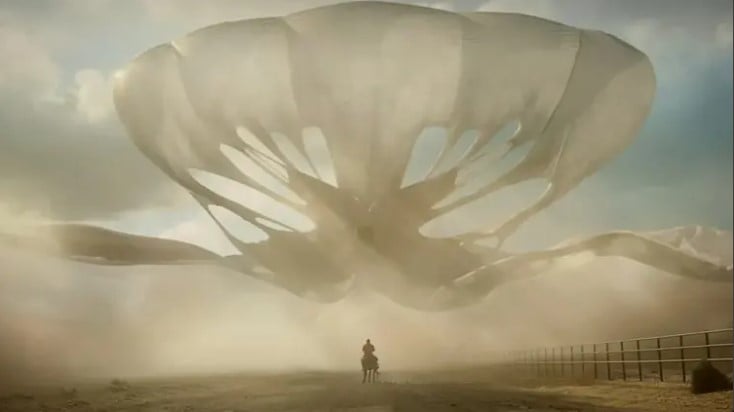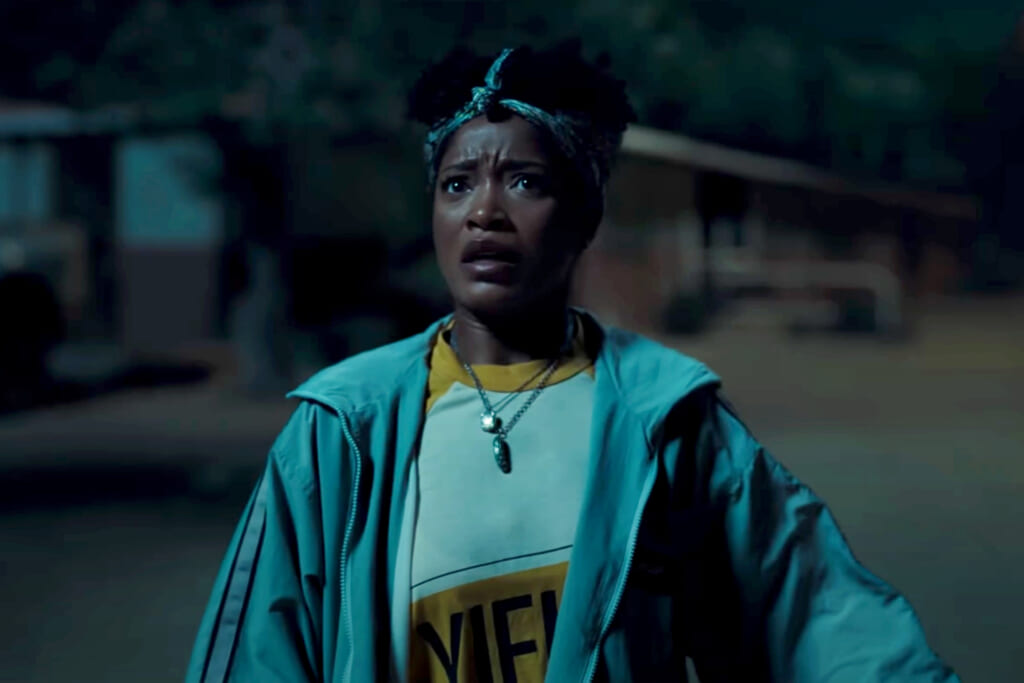Observations On Observations in ‘Nope’

Throughout Jordan Peele’s Nope, he explores how eye contact is received within different dynamics among people and animals. When a gaze is met between person to person or person to animal, it shapes how each relationship is formed. For the purpose of this piece, the UFO-like creature serving as the main antagonist of the film, Jean Jacket, is comparable to any other wild animal. It has to feed in order to grow, starting with smaller targets and becoming more experienced. Jean Jacket shows territorial tendencies over the land it has claimed. As far as the witnesses are aware, an attempt to domesticate has yet to occur. What is consistent, though, is that eye contact between a person and an animal often evokes a violent response in the beast.
The most substantial example of this observation is found in the primate, Gordy. Despite having a tolerance of his human environment, Gordy suddenly becomes violent. In the study “Social Structure Predicts Eye Contact Tolerance in Nonhuman Primates: Evidence from a Crowd-Sourcing Approach,” researchers Ethan G. Harrod, Christopher L. Coe, and Paula M. Niedenthal observe that “eye contact is an implicit signal of threat, and often connotes social status and imminent physical aggression” in most primates, these traits inspiring Jean Jacket’s physical reaction to “detection of direct gaze.” The desire to observe these reactions is Peele’s basis for much of the scientific thought behind the film’s interrogation of the human desire for spectacle.
Ricky “Jupe” Park
Ricky “Jupe” Park faced the consequences of spectacle at an early age. We first meet Jupe appearing as a child actor in the 1990s sitcom Gordy’s Home playing a boy called Mikey Houston” His experience on set after the brutal attack from Gordy which killed and disfigured his costars altered the way he would choose to live with his trauma.
Jupe is consistently disrespectful to animals even at an early age. He is a child actor—a boy with an adult job—and he shouldn’t be blamed for the violence that took place on the set of Gordy’s Home. However, participation in production alone is morally ambiguous. The actors involved weren’t personable with Gordy. Plus, it was likely known by the actors that chimps are by nature dangerous and unpredictable creatures, even when there is an attempt to “tame” them.
The sound of the balloon pop triggered the chimp playing Gordy. When all eyes were on him, it set him on an unconscious rampage. Then, we see the animal communicate confusion once his nerves are settled and he is suddenly alone with “Mikey.” In these victims’ cases, eye contact breaks the stability of Gordy and his “family’s” relationship.
The child interprets Gordy’s sparing of his life as a sign of his importance when in reality. It’s another one of Peele’s “bad miracles” he throws at his characters. Since he survived the attack completely uninjured, Jupe grows up believing he is the Chosen One. Now he wears that belief on his sleeve. He doesn’t understand that his life was spared by the mercy of a tablecloth and an oddly-placed shoe diverting the chimp’s gaze from his own up until someone could shoot the animal in the head.
Completely blinded by the fame that such an atrocity brought to him, he chooses to glorify his trauma instead of growing from it. Now a husband, father, and operator of Jupiter’s Claim, a western-themed amusement park that nods to Ricky’s previous child-acting years on the show Kid Sheriff, he takes advantage of a certain business opportunity involving a mysterious and unidentifiable aerial phenomenon that seems to have an appetite for his show-horses.
When Jupe ignorantly serves his entire audience to Jean Jacket at the park’s Star Lasso Experience, he stares back into the eyes of the monster with the faintest smile in his last moments before being swallowed and digested alive, hoping in his hubris that he’ll be remembered forever.
OJ Haywood, Jr.
In every way, OJ Haywood, Jr. is Jupe’s foil character, or rather the other way around. OJ is a humble man who struggles with social anxiety, though he deeply cares for his family’s legacy and the animals. The horse-whisperer understands animals better than people. He feels empathy more diversely than other characters in the film, even when it puts himself at risk, though that is not a negative quality to possess.

OJ was with his father the day a coin dropped from the sky, striking and killing Otis Sr. Another “bad miracle,” he acknowledges it as, and consequently, assumes heir to Haywood Hollywood Horses. The coin that struck him in the back of his skull punctured through his right eye, foreshadowing the theme of how breaking eye contact destroys the stability of relationships.
On a commercial set, OJ is gripped by social anxiety and struggles to communicate effectively with the other stage directors. The people aren’t showing OJ the respect or attention he needs in the situation, which worsens his nerves and inhibits him from making eye contact and speaking clearly. In the same way those people disrespected OJ, they disrespected his horse, Lucky, by going against instruction and looking into Lucky’s eyes. This startles the horse to buck his legs, echoing Gordy’s abhorrence of eye contact.
OJ isn’t making enough money with his family’s business. So he opts to sell a few horses to Jupiter’s Claim for live entertainment purposes, as he’s told. Bearing witness to a cloud-like figure seeming to devour both Ghost and Clover, concomitantly with his neighbor’s new Star Lasso Experience, he does what he can to save Lucky. He knows something dangerous is happening, but he still feels responsible for protecting the lives he feels accountable for unlike anyone else in the film.
He’s even respectful to the (very big) vermin messing with his farm and livelihood, Jean Jacket. Unlike other members of his crew, OJ keeps calm at all times when confronted with JJ’s territorial behaviors. Something is very honorable about OJ in that he does not try to destroy the creature out of vengeance for his father, his horses, his business partners, and all the destruction to his property. Faced with the opportunity to make his family’s name mean something even greater (in his own new way) and his previous experience training animals, OJ recognizes Jean Jacket’s behaviors as performed primally rather than with the conscientious effort put toward understanding consequences. This is why he justifies treating the space-sand dollar with respect. Additionally, his years of training animals make him think he has an authoritative understanding of Jean Jacket despite not understanding anything about its species.

What he does discover, though, is to not look directly at Jean Jacket. Consistently with other animals in the film, Jean Jacket understands eye contact under predatory dynamics between it and its food. If it wanted to, Jean Jacket could sneak up on its prey before catching them, but dominates victims with intimidation tactics.
Emerald Haywood
Whereas OJ’s gaze is more often met with horses than people, Emerald Haywood, or Em, is confident and perceptive in her behaviors. As the more assertive sibling, she steals the show during their commercial audition and reveals herself to be quite the girl boss. Her relationship with OJ is wonderfully wholesome, and the two intelligibly care about each other, despite OJ’s clear annoyance with Em always promoting her side hustles. Her personality is more unrestrained than OJ’s; she has fewer responsibilities, and she always has.
Otis Sr. favored OJ’s abilities over Em’s even as children, though they were both competent. Their father promised Em she could train her horse, which was named Jean Jacket. But in the end, he denied her that opportunity. Sexism in domestic life is commonplace among traditional households, and this did have a negative impact on Emerald’s self-image and willingness to work for her family. If anything, her trauma motivates her to make a name for herself, not her family, contrasting OJ’s overarching goals. She’s not weak, and she hasn’t given up on life. We see throughout the film she has had success in her life thus far. More focused on her own business pursuits, it’s no surprise when she wants to capitalize on the UAP by capturing it on video.

Emerald is good with animals, but not in the same way as OJ. Whereas her brother struggles to take control of people’s gaze and works better with his horses, Em works better with people. Her Lucky is her own steel steed, a motorcycle she uses to lure boss-mode Jean Jacket away from her brother. This is a moving scene in which we see both siblings risking martyrdom for one another.
As we learn more about the siblings’ lives, it’s revealed that the two can say a lot to one another with just their gaze. Much like in the study concerning eye contact in primates, where it “may be used to communicate complex emotional and mental states, and to establish affiliative bonds,” (Harrod, Coe, & Niedenthal) OJ and Em have built their relationship on a similar concept. The ability to understand the other person by simply looking into their eyes is the reason why the two love each other so much that they are willing to sacrifice themselves in the final scene with Jean Jacket.
On the opposite side of the spectrum, eye contact is intimidating and interpreted as aggressive to the animals. There is a cognitive dichotomy between humanity and animals we declare dominion over. The act of looking and being seen serves as both an evolutionary survival tactic as well as a bonding formality throughout Nope. In one aspect, it’s a predator-prey exchange, but the other is an exchange of love, empathy, and humanity. This film offers countless puzzles one can attempt to analyze, yet Nope explores how audiences can observe what it means to observe across species.
Source:
Harrod, E.G., Coe, C.L. & Niedenthal, P.M. Social Structure Predicts Eye Contact Tolerance in Nonhuman Primates: Evidence from a Crowd-Sourcing Approach. Sci Rep 10, 6971 (2020). https://doi.org/10.1038/s41598-020-63884-x
Categorized:Editorials News
